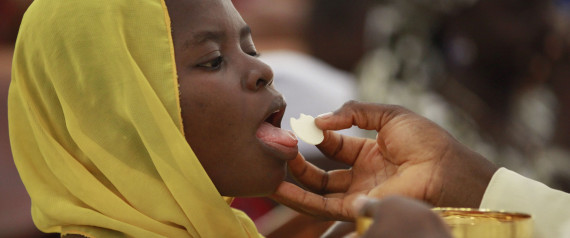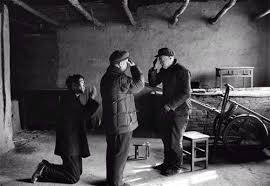A priest teaches new converts how to make the sign of the cross
Question 1: Why do Protestants number the Ten Commandments differently than we Catholics?
Answer: The Scriptures tell us that there were Ten Commandments, but do not indicate how they were divided. The Protestant division follows rather Ex. 20:2-27, while the Catholic follows Deut. 5:6-21. The Catholic division is older and more logical. We hold that desire for another man’s wife and desire for another man’s property are essentially two distinct crimes, and therefore, merit two separate commandments, the ninth and tenth. On the other hand, the first commandment insists on the virtue of religion and forbids all sins against that virtue, the chief of which is idolatry. Logically, therefore, the Protestant second commandment has no reason for being, and was born of the necessity of controversy to justify the early Reformers.
Question 2: Why does the priest mix a small amount of water with the wine to be consecrated?
Answer: The mingling signifies the union of the divine and human natures of Christ, as is beautifully expressed in the prayer then said by the priest, "By the mystery of this water and wine may we come to share in the divinity of Christ, who humbled himself to share in our humanity." This mingling also signifies our union with Him in Holy Communion.
Question 3: Why do we make the sign of the cross?
Answer: Nicephorus writes that St. John the Evangelist blessed himself with the sign of the cross before dying. St. Paul used this same sign to restore sight to a blind man. Many even affirm that Our Lord Himself taught this sign to the apostles and that he used it to bless them on the day of his Ascension. “The sign of the cross,” says St. Ignatius of Antioch, a disciple of St. John, “is the trophy raised against the power of the prince of this world; when he sees it, he is afraid; when he even hears of it, he is filled with terror.” Tertullian in the second century says, “At every fresh step and change of place, whenever we come in or go out…we impress upon our forehead the sign of the Cross.”
Our Lord's death sanctified (made holy) the symbol of the cross. The cross went from being regarded as an instrument of shame, to the symbol of Jesus' triumph and victory over sin and death and a sign of our faith in Him. That is why we make the sign of the cross.
If done with reverence and thought, the sign of the cross is a protection from the powers of Satan and a reminder of the power of our Faith. "In the name of the Father and of the Son and of the Holy Spirit," proclaims for all to see, our belief in the Trinity and the Unity of God in three persons. The touching of the forehead is to show that the Son proceeds from the Father, and that the Holy Spirit proceeds from both the Father and the Son is signified by touching the heart and the two shoulders; while the form of the cross reminds us of our redemption by Jesus' sacrifice the cross. Make the sign of the cross devoutly. It is one of the greatest sacramentals of the Church.
The cross is signed upon the forehead, lips and heart when the Gospel is read, to show that we must avoid sin in thought, word or deed, and professes our faith in these three ways.
Question 4: Does a person who receives the Sacrament of Confirmation with mortal sin on his soul commit a sacrilege?
Answer: He does; for Confirmation is a Sacrament of the living and can only be worthily received by those who are in a state of grace. The Sacraments of the living, remember, increase sanctifying grace in the soul that is already in union with God. Sacraments of the dead, as they are called, namely, Baptism and Reconciliation, give sanctifying grace to the soul that is not in union with God.
Question 5: What was the sin of Sodom?
Answer: When the people of Sodom and Gomorrah had given themselves up to sins of impurity, the evil of their crime was so great that, as the Scripture says, it cried out to heaven for vengeance (Gen. 18:20; 19:13). As a result, God showed his anger, "Then the Lord rained on Sodom and Gomorrah brimstone and fire from the Lord out of heaven; and he overthrew those cities, and all the valley, and all the inhabitants of the cities, and what grew on the ground" (Gen. 19:24-25). Thus that country, which before was "like the garden of the Lord" (paradise) (Gen. 13:10), was turned into a lake of stinking water, as tradition has it, which remains to this day as an eternal reminder of the loathing God has for the sins of uncleanness.
So, the answer to the question is that sodomy was the sin for which God destroyed Sodom and Gomorrah. The term includes all sins of unnatural lust, particularly those committed between persons of the same sex, and all practices aiming at the prevention of conception. Various distinctions, of no consequence here, are made by moral theology. But it always remains repugnant, unnatural lust that cries to heaven for vengeance.
Read more > > >



2 comments:
Thanks for the tid-bits. k
You are welcome, Kam!
God bless you.
Post a Comment